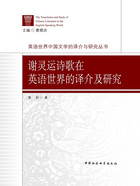
三 谢灵运诗歌的研究目的及意义
关于谢灵运诗歌在英语世界的研究成果,一直缺乏系统性的探讨。黄世中在《谢灵运研究论集》一书中的“《谢灵运研究丛书》编辑缘起”中谈及由于西文资料的缺乏,《谢灵运研究论集》外文卷被迫改为日韩卷[43]。另外,笔者所能找到的关于谢灵运在西方世界的零星介绍仅限于以下三篇论文:黄鸣奋的《英语世界中国先秦至南北朝诗歌之传播》[44]、程章灿的《欧美六朝文学研究管窥》[45] 及孙华娟的《于“陈腐”中开出花——评孙康宜〈抒情与描写——六朝诗歌概论〉》[46]。
西方学者立足于异质文化环境,以他者的眼光审视谢灵运,往往可以带来不同于国内学术界的观点。另外,对国外谢灵运研究成果的了解,也有利于建立一个立体的谢灵运诗歌接受史。所以笔者拟对20 世纪50年代以来谢灵运诗歌在英语世界的译介与研究状况作一梳理,评介西方学者解读谢灵运诗歌的独特视界,从而为国内的谢灵运研究提供参照和借鉴。
[1](南朝梁)刘勰著,范文澜注:《文心雕龙注》(上),人民文学出版社1958年点校本,第67页。
[2]曹道衡:《也谈山水诗的形成与发展》,《文学评论》1961年第2期,第32页。
[3](南朝梁)沈约:《宋书》卷六十七,中华书局1974年点校本,第1778页。
[4]余嘉锡撰,周祖谟、余淑宜整理:《世说新语笺疏》,中华书局1983年版,第262页。
[5](南朝宋)谢灵运,叶笑雪选注:《谢灵运诗选》,古典文学出版社1957年点校本,第7页。
[6](南朝梁)沈约:《宋书》卷六十七,中华书局1974年点校本,第1754页。
[7](唐)李延寿:《南史》卷三十四,中华书局1975年点校本,第881页。
[8](南朝梁)钟嵘著,曹旭集注:《诗品集注》,上海古籍出版社1994年点校本,第160页。
[9](唐)皎然著,李壮鹰校注:《诗式校注》,人民文学出版社2003年点校本,第118—119页。
[10](宋)严羽著,郭绍虞校释:《沧浪诗话校释》,人民文学出版社1961年点校本,第141页。
[11](清)沈德潜:《说诗啐语》,载王夫之等《清诗话》(下册),上海古籍出版社1963年点校本,第532页。
[12](清)方东树著,汪绍楹校点:《昭昧詹言》卷五,人民文学出版社1961年点校本,第129页。
[13](清)潘德兴著,朱德慈辑校:《养一斋诗话》,中华书局2010年点校本,第28页。
[14](明)许学夷著,杜维沫校点:《诗源辩体》卷七,人民文学出版社1987年点校本,第108页。
[15](清)汪师韩:《诗学纂闻》,载王夫之等《清诗话》(上册),上海古籍出版社1963年点校本,第454页。
[16](南朝梁)沈约:《宋书》卷六十七,中华书局1974年点校本,第1754页。
[17](南朝梁)沈约:《宋书》卷六十七,中华书局1974年点校本,第1778页。
[18](南朝梁)钟嵘著,曹旭集注:《诗品集注》,上海古籍出版社1994年点校本,第28页。
[19](清)方东树著,汪绍楹校点:《昭昧詹言》卷五,人民文学出版社1961年点校本,第126页。
[20](清)王士祯著,张宗柟纂集,戴鸿森校点:《带经堂诗话》(上),人民文学出版社1963年点校本,第115页。
[21]Richard B.Mather,“The Landscape Buddhism of the Fifth Century Poet Hsieh Ling-yun”,Journal of Asian Studies,Vol.18,Issue 1,Nov.,1958,pp.67-79.
[22]J.D.Frodsham,The Murmuring Stream:The Life and Works of the Chinese Nature Poet Hsieh Ling-yün(385-433),Duke of K’ang-Lo,2 vols,Kualar Lumpur:University of Malaya Press,1967.
[23]Francis Westbrook,Landscape Description in the Lyric Poetry and“Fuh on Dwelling in the Mountains”of Shieh Ling-yunn,Ph.D.diss.,Yale University,Ann Arbor,Mich.:UMI,1973.
[24]韦斯特布鲁克这里所说的最近几十年应该是指20 世纪50—70年代,其间主要有Richard B.Mather,“The Land scape Buddhism of the Fifth-century Poet Hsieh Ling-yün,”JAS XVIII 1958—1959.戴密微的有关谢灵运的研究成果集中在20 世纪60—70年代:Paul Demiéville,“langue et littérature chinoises,”in the“Résumé de Cours”of Exrait de l’Annuaire du collége de France,1963;Paul Demiéville,“A la mémoire d’un ami”,Asiatische Studien XVIII-XIX(1965),1-10;Paul Demiéville,Preséntation d’un poéte(T´oung Pao,56,1970).J.D.Frodsham.The Murmuring Stream:The life and works of the Chinese Natwe Poet Usieh Ling-yun(385-433),Puke of kang-Lo,2uols,Kualar Lunpur:University of Malaya Press,1967.
[25]Paul Demiéville,“langue et littérature chinoises”,in the“Résumé de Cours”of Exrait de l’Annuaire du collége de France,1963,pp.325-326.
[26]It is a hopeful sign for the future of Shieh Ling-yunn criticism that a scholar as reknowned [原文如此]as Demiéville should make such a statement on Shieh’s rightful place in Chinese literature at a time when important studies of the poet are beginning to appear.Francis Westbrook,Landscape Description in the Lyric Poetry and“Fuh on Dwelling in the Mountains”of Shieh Ling-yunn,Ph.D.diss.,Yale University,Ann Arbor,Mich.:UMI,1973,p.1.
[27]David Hinton,The Mountain Poems of Hsieh Ling-yun,New York:New Directions Publishing,2001.
[28]Liu Wu-chi and Irving Yucheng Lo,eds.,Sunflower Splendor:Three Thousand Years of Chinese Poetry,Indiana University Press,1976.
[29]Hans H.Frankel,The Flowering Plum and the Palace Lady:Interpretation of Chinese Poetry,New Haven:Yale University Press,1976.
[30]Burton Watson,The Columbia Book of Chinese Poetry—From Early Times to the Thirteenth Century,New York,London:Columbia University Press,1984.
[31]Victor H.Mair,ed.,The Columbia Anthology of Traditional Chinese Literature,New York:Columbia University Press,1994.
[32]Yip Wai-lim,Chinese Poetry:An Anthology of Major Modes and Genres,Durham:Duke University Press,1997.
[33]Cai Zong-qi,ed.,How to Read Chinese Poetry:A Guided Anthology,Now York:Columbia University Press,2008.
[34]Xiaofei Tian,Visionary Journeys:Trauel Writings from Early Medieual and Nineteenth-Century China,Cambridge(Massachusetts)and London:Harvard University Asia Center,Harvard University Press,2011.
[35]Kang-l Sun Chang,Six Dynasties Poetry,Drineton,New Jersey:Princeton University Press,1986,p.48,footnote 1.
[36]Timothy Wai Keung Chan,Considering the End:Mortality in Early Medieual Chinese Poetic Representation,Leiden:Brill Academic Publishers,2012.
[37]Burton Waton,Chinese Lyricism:Shih Poetry from the Second to the Twelfth Century,New York:Columbia University Press,1971.
[38]Wendy Swartz(田菱):《风景阅读与书写——谢灵运的易经运用》,李馥名译,载刘苑如主编《体现自然:意象与文化实践》,台湾“中央研究院”中国文哲研究所2012年版。
[39]Wendy Swartz,“Naturalness in Xie Lingyun’s Poetic Works”,Haruard Journal of Asiatic Studie,Vol 70,No 2,Dec,2010.
[40]Harrison Tse-Chang Huang,Excursion,Estates,and the Kingly Gaze:The Landscape Poetry of Xie Lingyun,Ph.D.diss.,University of California,Berkeley,Ann Arbor,Mich.:UMI,2010,pp.355-386.
[41]Selinda Ann Sheidan,Vocabulary and Style in Six Dynasties Poetry:A Frequency Study of Hsieh Ling-yun and Hsieh T’iao,Ph.D.diss.,University of Washington,Ann Arbor,Mich.:UMI,1982.
[42]生安锋、白军芳:《孙康宜教授访谈录》,《书屋》2008年第2期,第13页。
[43]参见葛晓音《谢灵运研究论集》中的“《谢灵运研究丛书》编辑缘起”。载葛晓音编选《谢灵运研究论集》,广西师范大学出版社2001年版,第2页。
[44]黄鸣奋:《英语世界中国先秦至南北朝诗歌之传播》,《贵州社会科学》1997年第2期,第50—55页。
[45]程章灿:《欧美六朝文学研究管窥》,《南京理工大学学报〈社会科学版〉》2008年第21卷第1期,第1—5页。
[46]孙华娟:《于“陈腐”中开出花——评孙康宜〈抒情与描写——六朝诗歌概论〉》,《中国诗歌研究动态》2004年第1辑,第145页。